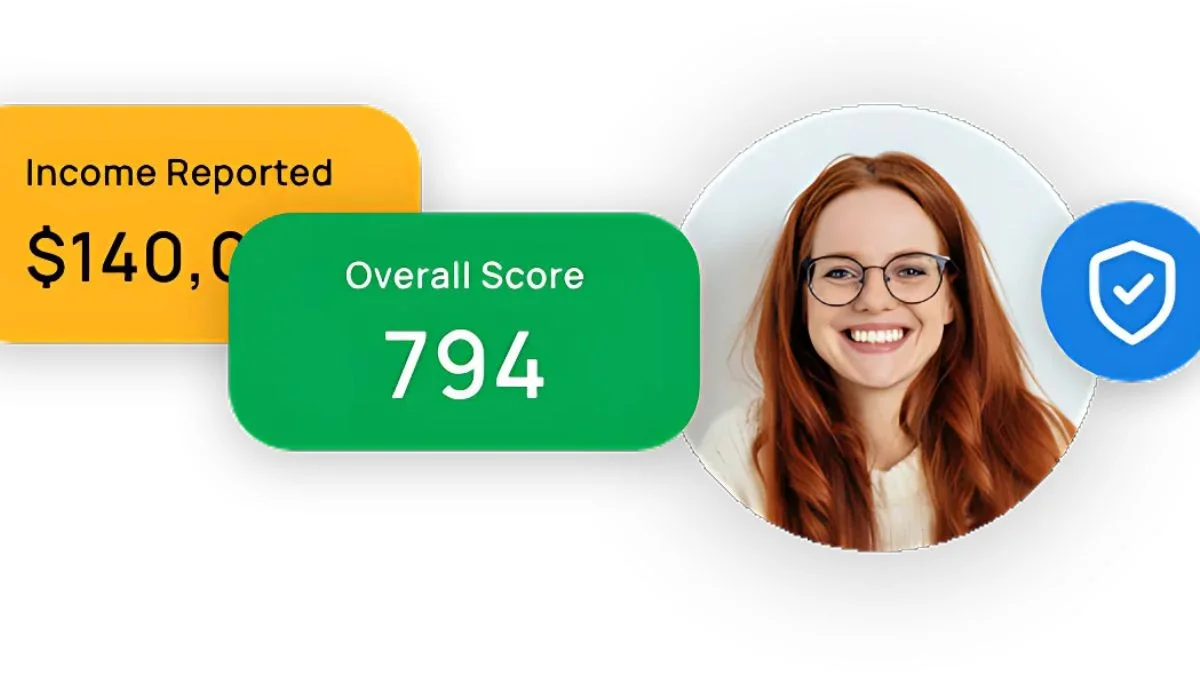When screening tenants, landlords often face a dilemma: should they rely on a traditional credit score or an RV Index Score? Understanding the differences between these scores can help landlords make better rental decisions. In this guide, we will explain what an RV Index Score is, how it differs from a credit score, and how landlords can use both effectively.
Key takeaways:
What is RV Index Score?
The RV Index Score (Resident Verify Index Score) is a tenant risk score designed to predict how likely a renter is to pay on time and comply with lease terms. Unlike credit scores, which cover loans, credit cards, and debt repayment, the RV Index Score focuses on rental-specific behaviors.

For example:
- A tenant who always pays rent on time but has little credit card use may have a low credit score.
- That same tenant might score high on the RV Index Score because their rental behavior is strong.
This distinction matters. Many renters today are “credit invisible” but have spotless rental records. A landlord depending only on credit scores could unfairly reject them.
In practice, the RV Index Score is generated by Resident Verify, which pulls data from:
- Rental applications
- Eviction records
- Public court documents
- Verified rental payments
This makes the score more relevant to landlords who care about rental reliability above all else. For landlords who want a deeper comparison between tenant scoring systems, it’s helpful to review how a resident score differs from a credit score.
What is a Good RV Index Score?
A good RV Index score typically indicates a low-risk tenant. The RV Index score range falls between 350 and 850:
- Above 700: A good RV Index Score. These tenants are low-risk, with steady income and clean rental history.
- 560–699: Medium risk. Landlords may want to request extra documentation, like income verification.
- Below 560: High risk. These applicants may have late payments, eviction history, or unstable income
The higher the score, the more reliable the tenant is likely to be. For example, Lisa has an RV Index Score of 720. She has a history of paying rent early, no evictions, and stable employment. Even if her credit score is only 620, landlords may still consider her a safe choice.
What is a Bad RV Index Score?
A bad RV Index score is typically a score below 560. A low score suggests a high-risk tenant. A bad RV Index Score signals issues such as:
- Prior eviction on record
- Frequent late rent payments
- Income that doesn’t meet rent-to-income standards
A bad score doesn’t always mean rejection. Some landlords use this as a trigger for extra checks, like asking for a bank statement or larger deposit.
For example:
- John has an RV Index Score of 690 but a modest credit score of 650. His consistent rental behavior makes him a safe choice.
- Hannah has a strong credit score of 710 but an RV Index Score of 500. This suggests her overall financial health looks fine, but her rental reliability may be questionable.
RV Index Score vs. Credit Score: Key Differences
While both scores assess a person's risk, they do so from different angles. The what is a resident score question is often answered by understanding that it is a specialized credit check for renters.
Key Components of Tenant Risk Scores

A comprehensive tenant risk score, like the RV Index Score, is built on a range of data. The what is a resident score question is best answered by looking at its components.
Credit History
Although the RV Index Score is not just a credit score, it does use credit data. It looks at a person's bill payment history, debt levels, and overall financial responsibility.
- Payment history (on-time vs. late bills)
- Outstanding debt levels
- Credit utilization ratio
- Public financial records (bankruptcies, foreclosures)
A high credit score to rent an apartment usually signals reliability, and the RV Index leverages this for better accuracy.
Rental History
This is a key differentiator. The score often includes data from previous landlords about a tenant's payment history and lease compliance. Data may include:
- On-time rent payments
- Lease compliance (e.g., fulfilling the full lease term)
- Property care reported by prior landlords
- Breaches like unauthorized subletting or noise complaints
A history of consistent, on-time rent payments is a strong positive signal.
Rent-to-income ratio
This ratio compares a tenant’s rent to their gross income. Landlords use this to verify a tenant’s ability to pay rent without financial strain. Most landlords look for tenants whose rent is less than 30% of gross income. A tenant earning $4,000/month should not rent an apartment over $1,200. You can confirm this using tenant income verification.
Eviction history
A record of a past eviction is a major red flag for landlords. A specialized tenant risk score will prominently feature this information. According to the Eviction Lab at Princeton University, around 2.7 million eviction cases are filed annually in the U.S. Tenants with even one eviction often fall below 50 on the RV Index scale.
Public records
This includes information like:
- Bankruptcies
- Civil judgments
- Tax liens
This information could directly affect a tenant's ability to pay rent.
Criminal background
While not always included in the score itself, many screening tools integrate a background check. Under HUD guidelines, landlords must evaluate criminal records carefully - blanket bans may violate the Fair Housing Act. Only relevant convictions (e.g., recent fraud, property damage, or violent crimes) may be considered.
Employment verification
This confirms a tenant’s job status and income. This may include:
- Verifying employer contact details
- Reviewing pay stubs or W-2s
- Cross-checking bank deposits (with tenant consent)
Some landlords may even ask for bank statements, although there are specific rules around this.
Benefits of Tenant Risk Scoring for Landlords

Tenant risk scores offer several advantages.
- Holistic View: They provide a more complete picture of a person’s rental risk than a traditional credit score alone.
- Improving Screening Efficiency: Tenant screening can be time-consuming, especially if landlords have multiple applicants. With risk scores, the process is faster and more standardized.
- Accuracy: By focusing on rental-specific data, these scores can be more accurate predictors of tenant behavior.
- Reduced Eviction Risk: Using a specialized score helps landlords avoid high-risk tenants, reducing the likelihood of late payments, property damage, and evictions.
Limitations of Tenant Risk Scores for Landlords

While tenant risk scores are valuable, they are not flawless. Landlords should be aware of the following limitations:
- Incomplete Picture: A score is just a number. It cannot capture factors like communication style, cleanliness, or how respectful a tenant will be toward neighbors. A tenant with a strong RV Index might still be a poor fit if they consistently violate noise rules.
- Discrepancies: Different scoring models may produce different results.One system may weigh eviction history more heavily, while another prioritizes income-to-rent ratio. This means the same applicant could score differently depending on the provider.
- Lack of Context: Sometimes, a low score reflects a single past issue.For example, a person may have a low score due to a single past issue that has since been resolved.
To balance fairness, landlords should always combine scores with other checks such as income verification and reference calls.
Which Score Should Landlords Trust: RV Index Score or Traditional Credit Score?
The question of RV index score vs credit score is a common one. Landlords should not trust one over the other but should use both for a comprehensive screening process.
The case for trusting the RV Index Score
The RV Index Score is a purpose-built tool. It is an ideal starting point for a landlord's screening process because it focuses on what matters most to a rental property owner: a tenant’s past rental behavior and their risk of eviction. A good RV index score is a strong indicator of a reliable renter.
The case for using the traditional credit score
A traditional credit score is still vital. While it may not predict rental behavior as directly, it provides a broader picture of a person's financial health. It shows how they manage debt and their overall financial stability, which is a strong indicator of their ability to pay rent consistently.
How Landlords Should Use Both RV Index Score and Traditional Credit Score?

The best approach is to use both tools together as part of a comprehensive tenant background screening.
1. Start with the RV Index (Resident) Score for Rental Risk
First, use the RV Index Score to quickly assess a tenant’s rental history and potential for eviction. This is the most relevant filter since it measures rental-specific data. For instance, if an applicant scores below 50 RV Index, they may pose too high a risk regardless of their credit score.
2. Use the Traditional Credit Score to Assess Overall Financial Health
Next, look at the traditional credit score. This gives you a snapshot of a person’s financial habits. See what landlords look for in a credit check to know what to focus on.
3. Resolve Discrepancies by Favoring Rental Behavior Data
If there’s a discrepancy (e.g., a good credit score but a poor RV Index score), it’s often best to prioritize the RV Index Score. The data is more relevant to your specific needs. This is the core of the resident score vs. credit score debate.
4. Combine with Other Tenant Screening Factors
A score is not enough. should be supplemented with:
- Background checks
- Income verification
- Employment history checks
- Soft and hard credit pulls
5. Set Clear Thresholds and Use Screening Tools
Establish clear policies to maintain fairness and compliance with the Fair Credit Reporting Act (FCRA). For example:
- RV Index Score ≥ 70
- Credit Score ≥ 650
- Rent-to-income ratio ≤ 30%
These thresholds help standardize decisions and protect against discrimination claims under the Fair Housing Act (FHA).
Conclusion
In the end, the smartest approach is to combine both the RV Index Score and a traditional credit score. Together, they give landlords the balance of rental-specific insights and broader financial health. But handling all of this on your own can be complicated.
With LeaseRunner, you can access RV Index Scores, credit checks, income verification, and background reports all in one place. It’s fast, compliant, and designed to make tenant screening easier for landlords.
FAQs
Q1: What is the RV index score calculator?
A: The RV index score calculator is a tool used by tenant screening companies to analyze various data points (like credit history, rental history, and public records) to produce an RV Index score for a prospective tenant.
Q2: Is the RV Index Score the same as a credit score?
A: No, they are not the same. A traditional credit score focuses on overall financial behavior (loans, credit cards), while the RV Index Score is specifically tailored for the rental industry, incorporating rental-specific data like eviction history.
Q3: Can I trust only the RV Index Score?
A: While the RV Index Score is a powerful tool, it’s best to use it in conjunction with a traditional credit score and other screening methods. A comprehensive approach provides the most accurate and complete picture of a potential tenant.







